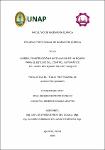Diseño, construcción e instalación de un equipo para el estudio del control automático del nivel de líquido en dos tanques

Date
2023Author
Honorio Rengifo, José Genaro
Molina Montes, Jhonatan Dejesús
Metadata
Show full item recordAbstract
The general objective of the present investigation was: being designed for, constructing and installing an equipment to accomplish the study of the automatic control of the level of liquid in two tanks adequately, for which it became elaborate firstly a sketch of the aforementioned team with the aim of analyzing the functioning of every one of their main components, which were: a PLC, an electric pump, two solenoid valves, an elevated tank, a tank that represented a powerhouse of liquid, a tank cistern, two breakers with float and an interface of communication. Straightaway, was used the software Zelio Soft V5.4.2, in order to elaborate and to play-act the best-suited logic circuit for the automatic control of the level of liquid in two tanks. The aforementioned logic circuit, it has served to determine the quantity of physical receipts and expenditures used in the PLC, the same ones that worked out: five (5) inputs and four physical exits (4). The connection order for the inputs and physical exits was the following: push-buttons I1 (NC), I2 (NA) and I5 (NA), they connected to the inputs (1, 2 and 5) of the PLC, respectively; the breakers with float I3 and I4, they connected to the inputs 3 and 4 of the PLC, respectively; the physical exits Q1 and Q3 of the PLC, they connect simultaneously to the electric pump; and the physical exits Q2 and Q4 and of the PLC, they connected to the solenoid valves 1 and 2, respectively. El objetivo general de la presente investigación fue: diseñar, construir e instalar un equipo para realizar adecuadamente el estudio del control automático del nivel de líquido en dos tanques, para lo cual se elaboró primeramente un esquema de dicho equipo con la finalidad de analizar el funcionamiento de cada uno de sus componentes principales, los cuales fueron: un PLC, una electrobomba, dos electroválvulas, un tanque elevado, un tanque que representaba a una fuente inagotable de líquido, un tanque cisterna, dos interruptores con flotador y una interfaz de comunicación. Seguidamente, se utilizó el software Zelio Soft2 V5.4.2, para elaborar y simular el circuito lógico más adecuado para el control automático del nivel de líquido en dos tanques. Dicho circuito lógico, ha servido para determinar la cantidad de entradas y salidas físicas utilizadas en el PLC, las mismas que resultaron: cinco (5) entradas y cuatro (4) salidas físicas. El orden de conexión para las entradas y salidas físicas fue el siguiente: los pulsadores I1 (NC), I2 (NA) e I5 (NA), se conectaron a las entradas (1, 2 y 5) del PLC, respectivamente; los interruptores con flotador I3 e I4, se conectaron a las entradas 3 y 4 del PLC, respectivamente; las salidas físicas Q1 y Q3 del PLC, se conectaron en forma paralela a la electrobomba; y las salidas físicas Q2 y Q4 del PLC, se conectaron a las electroválvulas 1 y 2, respectivamente. Se concluye la presente investigación, cumpliéndose de esta manera con el objetivo general y probándose la hipótesis general.
Collections
- Tesis [200]

